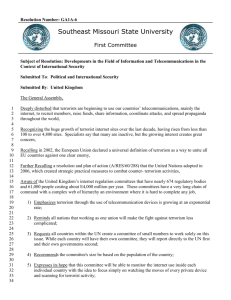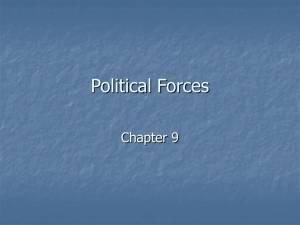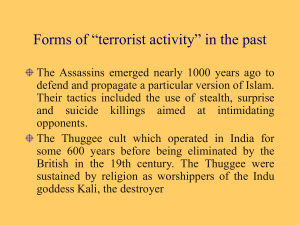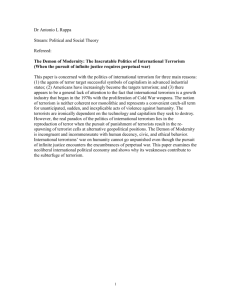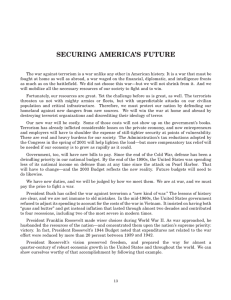July 11, 2008 The Honorable Christopher J. Dodd Chairman
advertisement
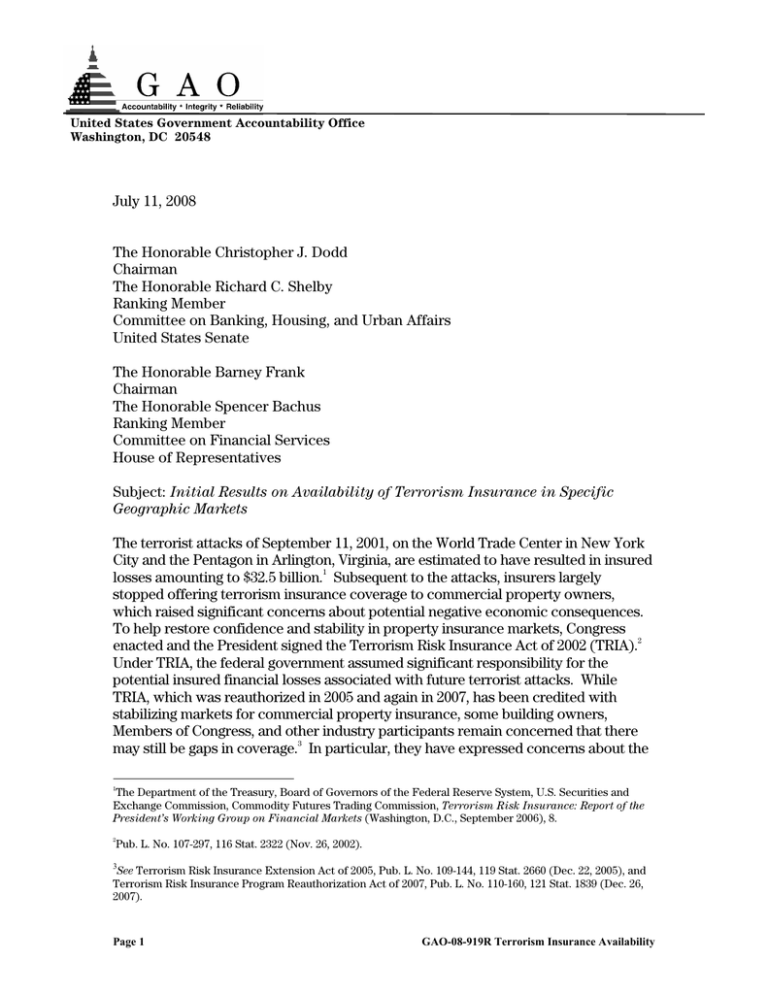
United States Government Accountability Office Washington, DC 20548 July 11, 2008 The Honorable Christopher J. Dodd Chairman The Honorable Richard C. Shelby Ranking Member Committee on Banking, Housing, and Urban Affairs United States Senate The Honorable Barney Frank Chairman The Honorable Spencer Bachus Ranking Member Committee on Financial Services House of Representatives Subject: Initial Results on Availability of Terrorism Insurance in Specific Geographic Markets The terrorist attacks of September 11, 2001, on the World Trade Center in New York City and the Pentagon in Arlington, Virginia, are estimated to have resulted in insured losses amounting to $32.5 billion.1 Subsequent to the attacks, insurers largely stopped offering terrorism insurance coverage to commercial property owners, which raised significant concerns about potential negative economic consequences. To help restore confidence and stability in property insurance markets, Congress enacted and the President signed the Terrorism Risk Insurance Act of 2002 (TRIA).2 Under TRIA, the federal government assumed significant responsibility for the potential insured financial losses associated with future terrorist attacks. While TRIA, which was reauthorized in 2005 and again in 2007, has been credited with stabilizing markets for commercial property insurance, some building owners, Members of Congress, and other industry participants remain concerned that there may still be gaps in coverage.3 In particular, they have expressed concerns about the 1 The Department of the Treasury, Board of Governors of the Federal Reserve System, U.S. Securities and Exchange Commission, Commodity Futures Trading Commission, Terrorism Risk Insurance: Report of the President’s Working Group on Financial Markets (Washington, D.C., September 2006), 8. 2 Pub. L. No. 107-297, 116 Stat. 2322 (Nov. 26, 2002). 3 See Terrorism Risk Insurance Extension Act of 2005, Pub. L. No. 109-144, 119 Stat. 2660 (Dec. 22, 2005), and Terrorism Risk Insurance Program Reauthorization Act of 2007, Pub. L. No. 110-160, 121 Stat. 1839 (Dec. 26, 2007). Page 1 GAO-08-919R Terrorism Insurance Availability ability of policyholders located in large urban areas that are viewed as being at high risk of attack to obtain terrorism insurance coverage. Under the 2007 statute that reauthorized TRIA coverage, GAO was required to conduct a study to determine if specific markets in the United States have any unique constraints on the amount of terrorism insurance available and to evaluate options to enhance coverage. This law required GAO to submit a report to the Committee on Banking, Housing, and Urban Affairs of the Senate and the Committee on Financial Services of the House of Representatives no later than June 23, 2008.4 The purpose of this report is to document our compliance with this reporting requirement. Enclosure I contains a copy of the briefing slides we used on June 20, 2008, and June 23, 2008, to brief committee staffs; the slides describe (1) whether the availability of terrorism insurance for commercial properties is constrained in any geographic markets and the impact of any constraints on pricing and coverage amounts, (2) factors limiting insurers’ willingness to provide coverage, and (3) advantages and disadvantages of some public policy options to increase the availability of property terrorism insurance.5 To assess whether the capacity, or willingness or ability, of the insurance industry to provide terrorism insurance is constrained in any geographic markets, we compiled and analyzed available data on insurance and reinsurance industry capacity, terrorism insurance take-up rates, and terrorism insurance pricing. We also interviewed more than 100 industry participants with nationwide perspective and expertise in specific geographic markets, including Atlanta, Boston, Chicago, New York, San Francisco, and Washington, D.C. We selected these high-, moderate-, and low-risk markets based on an industry analyst’s ranking of cities by risk of terrorism. Among others, we interviewed representatives of trade associations for insurers and policyholders, policyholders in a variety of industries, national and regional insurance and reinsurance brokers, staff at insurance and reinsurance companies, and state regulators. To identify the factors limiting insurers’ willingness or ability to provide terrorism insurance coverage, we interviewed representatives of national insurance companies holding a combined 37 percent to 52 percent market share in the states we studied as well as regional insurers. We also spoke with risk modeling firms and a credit rating agency. To obtain views on the advantages and disadvantages of some public policy options that have been proposed to increase insurers’ capacity to provide terrorism coverage, we relied on our interviews with industry participants described above. We also interviewed academics who have written on the topic of terrorism insurance, research organizations, and consumer interest groups. We conducted this performance audit from January 2008 to June 2008 in accordance with generally accepted government auditing standards. Those standards require 4 15 U.S.C. § 6701 note (Terrorism Insurance Program § 108(g)(3)). 5 The enclosed version of the slides contains some editing changes that we made following the committee briefings. Page 2 GAO-08-919R Terrorism Insurance Availability that we plan and perform the audit to obtain sufficient, appropriate evidence to provide a reasonable basis for our findings and conclusions based on our audit objectives. We believe that the evidence obtained to date provides a reasonable basis for our findings and conclusions based on our audit objectives. Background TRIA requires private insurers to offer terrorism coverage for commercial property and casualty insurance, including, among others, workers’ compensation insurance. Insurers must make terrorism coverage available to their policyholders on the same terms and conditions, including coverage levels, as other types of insurance coverage. For example, an insurer offering $100 million in commercial property coverage is required to offer $100 million in coverage for property damage from a certified terrorism event.6 However, insurers could impose an additional charge for this coverage, and policyholders have the option of not purchasing it. Under TRIA, the federal government is required to reimburse insurers for a portion of their losses from certified terrorist acts. Specifically, the federal government would reimburse insurers for 85 percent of their losses after the insurers pay a deductible amounting to 20 percent of the previous year’s direct earned premiums.7 The federal funding is activated when aggregate industry losses exceed $100 million and is capped at an annual amount of $100 billion.8 Originally enacted as a 3-year program, Congress has reauthorized the program twice and recently extended it until 2014. In December 2005, Congress passed the Terrorism Risk Insurance Extension Act that increased the required amount insurers would have to pay in the aftermath of a terrorist attack. In December 2007, Congress approved the Terrorism Risk Insurance Program Reauthorization Act and expanded the definition of an act of terrorism to include acts carried out by domestic actors. The act also clarified language on insurer’s liability, stating that insurers are not responsible for losses that exceed the federal government’s $100 billion annual liability cap. Commercial property insurance policies can be simple or complex, depending on the value and location of the properties being insured. Property owners may insure properties individually or consolidate multiple properties into a portfolio and insure them with a single policy. Terrorism coverage may be included in a policyholder’s all risk property insurance policy in which one or many insurers may participate, with each insurer providing a portion of the coverage up to the full amount of the policy. Or policyholders may obtain terrorism coverage 6 TRIA generally defines “act of terrorism” as any act that is certified as terrorism by the Secretary of Treasury, in concurrence with the Secretary of State and the Attorney General of the United States, and that is done in an effort to coerce, influence, or affect the conduct of the United States government or its civilian population. 15 U.S.C. § 6701 note (Terrorism Insurance Program § 102 (1)). 7 15 U.S.C. § 6701 note (Terrorism Insurance Program §§ 102(7)(F) and 103(e)(1)(A)). 8 15 U.S.C. § 6701 note (Terrorism Insurance Program § 103(e)). Page 3 GAO-08-919R Terrorism Insurance Availability through a stand-alone insurance policy from a separate insurer that may cost more than the all risk property coverage. Some policyholders may self-insure for terrorism risk through a captive insurer, which insures the liabilities of its owner. Summary While commercial property terrorism insurance coverage appears to be available nationwide at rates policyholders view as reasonable, certain policyholders may face challenges in obtaining desired amounts of coverage or obtaining coverage at prices they view as reasonable. The policyholders experiencing these challenges were typically those that own large, high-value properties in areas where many large buildings are clustered, particularly in urban areas viewed as at high risk of attack, such as Manhattan, and to a lesser extent certain areas of other major cities, such as Chicago and San Francisco, according to policyholders and brokers. To address challenges in obtaining terrorism insurance coverage, policyholders we contacted reported taking a variety of approaches. For example, some policyholders purchased coverage from a large number of insurers in complex insurance programs, adding to what can be a time-consuming and onerous process for policyholders and their insurance brokers. Others purchased coverage in a separate policy (rather than as part of an overall property insurance package), which policyholders said may be more costly, or self-insured. Policyholders said that, through such approaches, they have generally been able to meet their current requirements for terrorism insurance coverage. They also attributed their ability to obtain coverage, as did insurers and industry analysts, to the TRIA program, with some industry participants citing the current “soft” (or competitive) insurance market as contributing to availability. While TRIA limits insurers’ financial exposure related to future terrorist attacks, several insurers said they remained concerned about the exposure they retain, and their efforts to minimize potential losses appear to be the primary reason some policyholders face challenges in obtaining coverage. Insurers said they seek to mitigate potential losses from a single terrorism event by limiting the amount of property coverage that they offer in specific areas of cities, such as downtown locations or financial districts where many large buildings are clustered, or in specific areas of cities considered to be at high risk of attack, such as parts of Manhattan. These exposure limits, referred to here as aggregation limits, generally make obtaining coverage more difficult or costly for certain policyholders in these areas, according to a variety of sources we contacted. Insurance industry participants and analysts had no consensus on whether TRIA should be modified or additional actions taken to increase the availability of terrorism insurance coverage. Industry analysts and participants identified the following advantages and disadvantages of various policy proposals that have been made to increase terrorism insurance coverage. • Page 4 One proposal involves lowering insurers’ TRIA deductibles in areas affected by a future large terrorist attack under the premise that further relieving insurers of the financial consequences of such attacks would GAO-08-919R Terrorism Insurance Availability make them more willing to offer terrorism insurance coverage.9 Some insurers and industry participants we contacted said that this proposal could make insurers more willing to offer coverage in areas affected by an attack or series of attacks. However, others said that the proposal’s effects may be limited. While the proposal would substantially reduce the TRIA deductible, officials we contacted said that it may not make insurers willing to offer more terrorism insurance coverage in the wake of a future terrorist attack that caused substantial insured losses. This proposal could also increase federal exposure to losses caused by terrorism. • Some industry participants believe that another option, allowing insurers to establish tax-deductible reserves for terrorist attacks, could increase insurers’ ability to provide terrorism insurance coverage. However, others said that establishing the appropriate size of such reserves would be difficult.10 We have also previously reported that industry analysts have argued that federal tax revenues would decrease under this proposal. In addition, we reported that other analysts said this proposal might not increase capacity because primary insurers might use the reserves as a substitute for reinsurance (insurance for insurers) since reinsurance premiums are already tax deductible.11 • Finally, some industry analysts and participants said that changing the federal tax code to encourage the issuance of catastrophe bonds within the United States could allow capital from the securities markets to help cover the potential costs of terrorist attacks.12 However, others said that developing such bonds for terrorism would be extremely difficult and that investors may have very limited interest in them. In addition, as we previously reported, the federal government could lose tax revenue under such a proposal. 9 See S. 2621, 110th Cong. § 2 (2008) and H.R. 4721, 110th Cong. § 2 (2007), two legislative proposals to reset the TRIA deductible after a large terrorist event where aggregate industry insured losses exceed $1 billion. 10 Current tax laws and accounting principles discourage U.S. property and casualty insurers from accumulating long-term assets specifically for payment of future losses by taxing these assets. Because the size and timing of disasters that have not taken place is uncertain, assets set aside for catastrophe losses, together with any interest accrued, are taxed as corporate income in the year in which they are set aside. 11 See GAO, Catastrophe Risk: U.S. and European Approaches to Insure Natural Catastrophe and Terrorism Risks, GAO-05-199 (Washington, D.C.: Feb. 28, 2005). 12 Catastrophe bonds have generally been issued to cover natural events, such as earthquakes or hurricanes, rather than terrorist attacks. A catastrophe bond offering is typically made through an investment entity that may be sponsored by an insurance or reinsurance company. The investment entity issues bonds or debt securities for purchase by investors. These investment entities are typically established offshore, and therefore, are not subject to federal taxation. One proposal has suggested that making onshore investment entities tax exempt could increase the use of such bonds. For additional information about catastrophe bonds and related tax issues, see GAO, Catastrophe Insurance Risks: The Role of Risk-Linked Securities and Factors Affecting Their Use, GAO-02-941 (Washington, D.C.: Sept. 24, 2002); GAO, Catastrophe Insurance Risks: Status of Efforts to Securitize Natural Catastrophe and Terrorism Risk, GAO-03-1033 (Washington, D.C.: Sept. 24, 2003); and GAO-05-199. Page 5 GAO-08-919R Terrorism Insurance Availability We provided a draft of the enclosed briefing to the Treasury Department and the National Association of Insurance Commissioners. We received technical comments from the Treasury Department that were incorporated where appropriate. ---We are sending copies of this report to interested committees and parties. We also make copies available to others upon request. In addition, the report will be available at no charge on GAO’s Web site at http://www.gao.gov. As agreed with your staff, we plan to publish a more detailed report on this topic later this year. If you or your staffs have any questions about this report, please contact me at (202) 512-8678 or jonesy@gao.gov. Contact points for our Offices of Congressional Relations and Public Affairs may be found on the last page of this report. Major contributors to this report were Wes Phillips, Assistant Director; Jill Naamane; Kathryn Supinski; Shamiah Woods; and Ethan Wozniak. Yvonne D. Jones Director, Financial Markets and Community Investment Enclosure Page 6 GAO-08-919R Terrorism Insurance Availability Enclosure I: Briefing to House Financial Services and Senate Banking, Housing, and Urban Affairs Committees Initial Results on Terrorism Insurance Availability in Specific Geographic Markets Briefing to the House Financial Services Committee June 20, 2008 Briefing to the Senate Banking, Housing, and Urban Affairs Committee June 23, 2008 Page 7 GAO-08-919R Terrorism Insurance Availability Overview • Objectives • Summary of Findings • Background • Scope and Methodology • Discussion of Findings 2 Page 8 GAO-08-919R Terrorism Insurance Availability Objectives • Discuss whether the availability of terrorism insurance for commercial properties is constrained in any geographic markets and the impact of any such constraints on coverage amounts and pricing. • Discuss the factors limiting insurers’ willingness to provide terrorism insurance for commercial properties. • Describe the advantages and disadvantages of some public policy options that have been proposed to increase the availability of property terrorism insurance. 3 Page 9 GAO-08-919R Terrorism Insurance Availability Summary of Findings • While terrorism insurance coverage currently appears to be widely available to commercial policyholders on a nationwide basis at rates policyholders viewed as favorable, some policyholders in urban areas (particularly Manhattan) experience challenges obtaining desired amounts of coverage or obtaining coverage at prices viewed as reasonable. • To address these challenges, these policyholders, many of whom own large high-value buildings that are clustered in downtown locations or financial districts, reported having to obtain coverage through a greater number of insurers in what may already be complex insurance programs, purchasing coverage in special insurance markets, or self-insuring. • Through such approaches, policyholders have generally been able to meet their current terrorism insurance requirements, according to such policyholders and insurance brokers. • Many industry participants and analysts cited the federal Terrorism Risk Insurance Act of 2002 (TRIA) program and the current “soft” (or competitive) insurance market as the main reasons that terrorism coverage is generally available, even to policyholders in high-risk areas. 4 Page 10 GAO-08-919R Terrorism Insurance Availability Summary of Findings • While TRIA limits insurers’ potential losses in the event of a future terrorist attack, insurers’ efforts to manage the risks that they do face appeared to be the primary reasons certain policyholders might experience challenges in obtaining coverage. • To mitigate their potential losses, many insurers set limits on the amount of coverage that they will provide to policyholders in confined geographic areas within a city, making obtaining coverage more difficult or costly for certain policyholders. • There was no consensus among insurance industry participants and analysts on whether TRIA should be modified or additional actions taken to increase the availability of terrorism insurance. We cite several advantages and disadvantages of the various proposals that have been made to do so in recent years. • For example, some industry participants told us that lowering insurers’ TRIA deductibles in areas affected by a large terrorist attack might help increase insurers’ willingness to offer coverage, but others disagreed and thought that any increased willingness would be limited. • This proposal could also increase the federal government’s exposure to terrorism losses. 5 Page 11 GAO-08-919R Terrorism Insurance Availability Background • Congress passed TRIA after commercial property insurance coverage for terrorism events became unavailable due to the terrorist attacks of September 11, 2001. • Under TRIA, when aggregate insured losses exceed $100 million, the federal government would reimburse commercial property/casualty insurers for 85 percent of their losses, up to $100 billion annually, after the insurers pay a deductible. • TRIA requires insurers to offer coverage for terrorist events on the same terms and conditions, including coverage levels, of other types of nonterrorism coverage, but policyholders may choose to reject it. • The federal government may later recover its payments through assessments on policyholders. • On December 26, 2007, TRIA was reauthorized until 2014. • The reauthorization adds domestic terrorism to the program and clarifies that insurers are not responsible for losses exceeding $100 billion. 6 Page 12 GAO-08-919R Terrorism Insurance Availability Background • Commercial property terrorism insurance programs can be simple or complex, depending on the value and location of the properties being insured. • Policyholders may insure properties individually or insure multiple properties from various locations within a portfolio. • One primary insurer may provide all the coverage or many primary insurers may participate in a layered program, with each insurer providing a portion of the coverage up to the full amount of the policy. • Reinsurers may assume some of the risk that primary insurers incur in providing property insurance, including terrorism coverage, in exchange for premiums. • Terrorism coverage may be included in a policyholder’s standard property insurance policy or provided through a standalone terrorism insurance policy. 7 Page 13 GAO-08-919R Terrorism Insurance Availability Scope and Methodology • Scope • Commercial property/casualty insurance in national and selected geographic markets (Atlanta, Boston, Chicago, New York, San Francisco, and Washington, D.C.). • Methodology • Reviewed relevant literature. • Compiled and analyzed available data on insurance and reinsurance industry capacity, terrorism insurance take-up rates, and terrorism insurance pricing. • Interviewed industry participants with national market perspectives. • Interviewed industry participants with specific market perspectives. • We conducted this performance audit from January 2008 to June 2008 in accordance with generally accepted government auditing standards. Those standards require that we plan and perform the audit to obtain sufficient, appropriate evidence to provide a reasonable basis for our findings and conclusions based on our audit objectives. We believe that the evidence obtained to date provides a reasonable basis for our findings and conclusions based on our audit objectives. 8 Page 14 GAO-08-919R Terrorism Insurance Availability Scope and Methodology • Interviews of participants with a national perspective included • insurance/reinsurance industry trade associations, • policyholder groups, • national insurance and reinsurance brokers, • national insurance and reinsurance companies, • policyholders with nationwide property portfolios, • risk modeling firms, • rating agency, • academics/research organizations, and • consumer interest groups. • Interviews of parties with specific market perspectives included • state regulators, • regional/local insurance brokers, • regional/local insurance companies, and • local policyholders. 9 Page 15 GAO-08-919R Terrorism Insurance Availability Scope and Methodology • We selected geographic markets to study based on an industry analyst’s ranking of cities by risk of terrorism. We selected a range of cities the organization considers to be at high, moderate, and low risk of attack. • High-risk cities: Chicago, New York, San Francisco, and Washington, D.C. • Moderate-risk city: Boston • Low-risk city: Atlanta • We also obtained perspectives on the availability and affordability of terrorism insurance in other areas considered to be at low risk of a terrorist attack from parties with a national market perspective. 10 Page 16 GAO-08-919R Terrorism Insurance Availability Scope and Methodology • Interview statistics as of June 6, 2008 • Conducted interviews with more than 100 organizations. • Interviewed 8 large insurance companies that hold combined commercial property/casualty market shares of between 37 percent and 52 percent in the states we studied. • Interviewed one of the largest worldwide reinsurers and 5 of the 15 largest Bermuda reinsurers as ranked by capital. • Interviewed policyholders representing the real estate, transportation, financial services, health, hospitality, and entertainment industries, including those representing • more than 200 properties in New York, • more than 100 properties in Washington, D.C., • at least 30 properties each in Chicago and San Francisco, • about 30 properties in Boston and 60 in Atlanta, and • numerous properties across the United States including other major cities such as Los Angeles and Houston. 11 Page 17 GAO-08-919R Terrorism Insurance Availability Terrorism insurance widely available, but some policyholders experience challenges • According to a variety of sources we contacted, property terrorism coverage currently seems to be widely available nationwide at rates viewed as affordable. • According to a large national broker, prices for terrorism insurance have been generally stable since 2003 (fig. 1 on next page). • According to a large national broker, the overall percentage of companies purchasing coverage has remained steady at around 60 percent since 2005 (fig. 2 on next page), with more than 80 percent of the real estate sector purchasing coverage in 2007. • This broker also reported that the Northeast has the largest percentage of companies (around 70 percent in 2007) that purchase property terrorism coverage. 12 Page 18 GAO-08-919R Terrorism Insurance Availability Terrorism insurance widely available, but some policyholders experience challenges Figure 1: Median Terrorism Insurance Premiums as a Percentage of U.S. Commercial Property Premiums Figure 2: Percentage of Companies Purchasing Property Terrorism Insurance in the United States 13 Page 19 GAO-08-919R Terrorism Insurance Availability Terrorism insurance widely available, but some policyholders experience challenges • However, many industry participants reported that some policyholders located in urban areas viewed as being at higher risk of terrorist attack, particularly in Manhattan, experienced challenges obtaining desired amounts of coverage at prices they viewed as reasonable. Large national brokers also mentioned policyholders experiencing challenges to a lesser extent in certain areas of other major cities such as Chicago and San Francisco. • Policyholders who own large high-value properties (e.g., large office buildings and hotels) in areas where many large buildings are clustered, generally in downtown locations or financial districts, or policyholders with properties in proximity to high-risk properties were more likely to experience these challenges, according to policyholders and brokers. • Many industry participants reported that premiums were higher in cities considered to be high-risk. For example, according to one large insurance broker, terrorism insurance premiums in New York can be twice as high as prices for similar buildings in other cities considered to be at high-risk of a terrorist attack, and over five times higher than prices in lower-risk cities. 14 Page 20 GAO-08-919R Terrorism Insurance Availability Terrorism insurance widely available, but some policyholders experience challenges • According to insurance brokers and policyholders, policyholders have generally been able to respond to such challenges and meet current terrorism insurance requirements by taking several steps, including • obtaining coverage from a greater number of insurers in what may already have been a complex insurance program, which can be a time-consuming and onerous process for policyholders and their insurance brokers; • purchasing terrorism coverage in a separate policy from an insurer offering standalone terrorism coverage, which may be more costly; or • placing a portion or all of their terrorism coverage in a captive insurer (captives are typically established by large corporations to self insure various risks) and gaining direct access to the reinsurance market and coverage through TRIA. 15 Page 21 GAO-08-919R Terrorism Insurance Availability Terrorism insurance widely available, but some policyholders experience challenges • Insurers, policyholders, and industry analysts cited the TRIA program as a key reason that terrorism coverage is generally available, even for policyholders that own or manage highprofile properties in urban areas viewed as at high risk of attack. • Some industry participants also cited the current “soft,” or competitive, insurance market as generally contributing to terrorism insurance availability. In a soft market, insurance is widely available and sold at a lower cost, making it easier for buyers to obtain insurance. • However, some interviewees cautioned that another terrorist attack or change in the insurance business cycle could reduce the current supply of terrorism insurance coverage. 16 Page 22 GAO-08-919R Terrorism Insurance Availability Insurers’ efforts to mitigate potential losses contribute to terrorism coverage challenges • While TRIA limits insurers’ potential losses from future terrorist attacks, several companies we contacted remain significantly concerned that such an event could still cause them substantial losses. The steps that insurers have taken to mitigate such losses appear to be the primary reason some policyholders face challenges obtaining the desired amount of coverage or coverage at a price viewed as reasonable. • Insurers said that they seek to mitigate potential losses from a single terrorism event by limiting the amount of property coverage that they offer in confined geographic areas within a city. These exposure limits, referred to here as aggregation limits, generally make obtaining coverage more difficult or costly for certain policyholders, according to a variety of sources we contacted. • Insurers monitor the amount of coverage that they provide in confined geographic areas within cities on an ongoing basis to help ensure that they do not exceed their aggregation limits. 17 Page 23 GAO-08-919R Terrorism Insurance Availability Insurers’ efforts to mitigate potential losses contribute to terrorism coverage challenges • To manage their aggregation limits and make underwriting decisions, several industry participants we interviewed said insurers often use some variation of the following strategies. • Estimate their potential losses from terrorist attacks in particular areas, under varying scenarios, by using models available from risk modeling firms. Insurers do not typically use models to estimate the probability of an attack. Models take into account the number and size of buildings in the insurers’ portfolio, the proximity of nearby buildings, and the effects of attack scenarios in the area (e.g., a 5 or 10 ton truck bomb). • Consider the extent to which one such event could trigger losses among multiple lines of insurance involving the insured property, business interruption, or individuals in the buildings. • Impose internal limits on the amount of coverage they will offer within the defined areas based on these attack scenarios (fig. 3). 18 Page 24 GAO-08-919R Terrorism Insurance Availability Insurers’ efforts to mitigate potential losses contribute to terrorism coverage challenges • For example, an insurer may decline to provide coverage for this new property since adding the property to the portfolio would exceed the insurer’s internal limit on exposures within the defined area. Figure 3: An insurer’s underwriting decision based on aggregation of risk 19 Page 25 GAO-08-919R Terrorism Insurance Availability Insurers’ efforts to mitigate potential losses contribute to terrorism coverage challenges • Other factors industry participants reported as influencing insurers’ willingness to offer coverage include • rating agencies’ views on the amount of capital allocated to terrorism risk and location of risks; • availability of reinsurance; and • state rate regulation and the extent of market pressure to keep rates competitive. • Based on our interviews to date, the recent changes in TRIA do not seem to have affected the availability or affordability of terrorism insurance. Policyholders we contacted that have recently renewed policies said their insurers did not revise coverage amounts or premiums as a result of these changes. 20 Page 26 GAO-08-919R Terrorism Insurance Availability Insurers’ efforts to mitigate potential losses contribute to terrorism coverage challenges • The provision in TRIA requiring insurers to offer terrorism coverage at terms and conditions that do not differ materially from other coverage does not apply to reinsurers, so these companies have discretion in deciding how much terrorism coverage to offer to primary companies. • Reinsurance companies reported similar factors to those described by primary insurers as affecting their willingness to offer coverage, such as • efforts to manage their aggregation levels, • rating agencies’ views on the company’s risk exposures, and • the amount of premium that can be collected to compensate for covering various terrorism risks. 21 Page 27 GAO-08-919R Terrorism Insurance Availability Advantages and disadvantages of options to increase capacity • We did not find a consensus among industry participants on whether TRIA should be modified or additional actions taken to increase the availability of terrorism insurance coverage. We found that various policy proposals that have been made to increase terrorism insurance coverage have both advantages and disadvantages. • This section discusses some of the advantages and disadvantages industry participants and analysts identified as associated with • lowering insurers’ TRIA deductibles in areas affected by a large terrorist event; • allowing insurers to establish tax-deductible reserves for future terrorist events; and • facilitating the use of catastrophe bonds for terrorism risk, through changes in the federal tax code. 22 Page 28 GAO-08-919R Terrorism Insurance Availability Advantages and disadvantages of options to increase capacity • Lower insurers’ TRIA deductibles in areas affected by a future large terrorist attack. • Some insurers and industry analysts said this option would allow them to offer additional terrorism insurance coverage or increase their willingness to continue to offer coverage if there was another terrorist attack or series of attacks. • However, other industry participants and analysts said that the impact of this proposal on terrorism insurance markets following another terrorist attack likely would be limited. Several industry participants said that while this proposal lowers the TRIA deductible substantially, it may not make insurers willing to offer more terrorism insurance coverage in the wake of a future attack that results in substantial insured losses. • This proposal could also increase the federal exposure to terrorism losses. 23 Page 29 GAO-08-919R Terrorism Insurance Availability Advantages and disadvantages of options to increase capacity • Allow insurers to establish tax-deductible reserves for future terrorism losses. • Some industry participants we interviewed said this proposal may allow insurers, over time, to increase their ability to provide terrorism insurance coverage. In addition, they said if insurers were able to establish reserves, a large terrorist attack could cause less of a strain or shock to industry surplus, or capital. • However, others noted that it is difficult to determine the appropriate amount to retain in reserve because the frequency of terrorist attacks is difficult to estimate. One participant also noted that maintaining a large amount of funds in reserve for a terrorist attack could limit insurers’ ability to provide coverage for other types of perils, such as hurricanes. • In addition, we previously reported that industry analysts believe (1) federal tax revenues would decrease under this proposal, and (2) overall terrorism insurance capacity might not increase because insurers might use the reserves as a substitute for reinsurance that may have been previously purchased to manage the risks of potential terrorist attacks (reinsurance premiums are tax deductible). 24 Page 30 GAO-08-919R Terrorism Insurance Availability Advantages and disadvantages of options to increase capacity • Facilitate the onshore issuance and use of catastrophe bonds for terrorism through changes to the federal tax code. • Some industry participants noted that this proposal could add capacity to the market because it would expand the pool of capital available to cover terrorism risk and insurers might be willing to write more coverage if they were able to transfer the risk to investors. • However, others said that investors currently have a very limited appetite for terrorism risk. They also said that it would be very difficult to price and structure a catastrophe bond for terrorism because the frequency of such events is difficult, and perhaps, impossible to estimate with any reliability. • In addition, the federal government could lose tax revenue and the proposed changes to the tax code might create pressure from other industries for similar tax treatment. 25 (250406) Page 31 GAO-08-919R Terrorism Insurance Availability This is a work of the U.S. government and is not subject to copyright protection in the United States. The published product may be reproduced and distributed in its entirety without further permission from GAO. However, because this work may contain copyrighted images or other material, permission from the copyright holder may be necessary if you wish to reproduce this material separately. GAO’s Mission The Government Accountability Office, the audit, evaluation, and investigative arm of Congress, exists to support Congress in meeting its constitutional responsibilities and to help improve the performance and accountability of the federal government for the American people. GAO examines the use of public funds; evaluates federal programs and policies; and provides analyses, recommendations, and other assistance to help Congress make informed oversight, policy, and funding decisions. GAO’s commitment to good government is reflected in its core values of accountability, integrity, and reliability. Obtaining Copies of GAO Reports and Testimony The fastest and easiest way to obtain copies of GAO documents at no cost is through GAO’s Web site (www.gao.gov). Each weekday, GAO posts newly released reports, testimony, and correspondence on its Web site. To have GAO e-mail you a list of newly posted products every afternoon, go to www.gao.gov and select “E-mail Updates.” Order by Mail or Phone The first copy of each printed report is free. Additional copies are $2 each. A check or money order should be made out to the Superintendent of Documents. GAO also accepts VISA and Mastercard. Orders for 100 or more copies mailed to a single address are discounted 25 percent. Orders should be sent to: U.S. Government Accountability Office 441 G Street NW, Room LM Washington, DC 20548 To order by Phone: Voice: TDD: Fax: (202) 512-6000 (202) 512-2537 (202) 512-6061 To Report Fraud, Waste, and Abuse in Federal Programs Contact: Congressional Relations Ralph Dawn, Managing Director, dawnr@gao.gov, (202) 512-4400 U.S. Government Accountability Office, 441 G Street NW, Room 7125 Washington, DC 20548 Public Affairs Chuck Young, Managing Director, youngc1@gao.gov, (202) 512-4800 U.S. Government Accountability Office, 441 G Street NW, Room 7149 Washington, DC 20548 Web site: www.gao.gov/fraudnet/fraudnet.htm E-mail: fraudnet@gao.gov Automated answering system: (800) 424-5454 or (202) 512-7470 PRINTED ON RECYCLED PAPER
